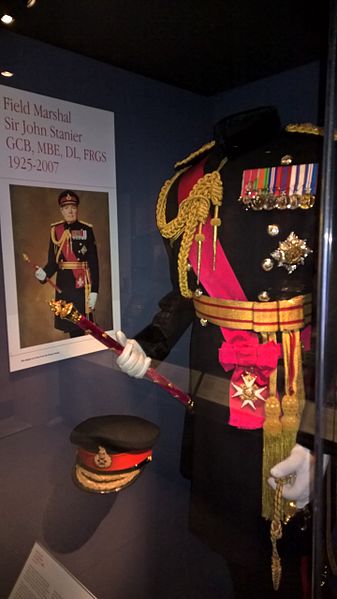Field Marshal Sir John Fox Burgoyne, 1st Baronet, was a British Army officer. After taking part in the Siege of Malta during the French Revolutionary Wars, he saw action under Sir John Moore and then under the Duke of Wellington in numerous battles of the Peninsular War, including the Siege of Badajoz and the Battle of Vitoria. He served under Sir Edward Pakenham as chief engineer during the War of 1812. He went on to act as official advisor to Lord Raglan during the Crimean War advocating the Bay of Kalamita as the point of disembarkation for allied forces and recommending a Siege of Sevastopol from the south side rather than a coup de main, so consigning the allied forces to a winter in the field in 1854.
Lieutenant General Sir John Fox Burgoyne, GCB, photo by Roger Fenton, 1855
Siege of Sevastopol by Franz Roubaud
Statue in Waterloo Place, London
Funerary monument, Brompton Cemetery, London
Field marshal (United Kingdom)
Field marshal (FM) has been the highest rank in the British Army since 1736. A five-star rank with NATO code OF-10, it is equivalent to an Admiral of the Fleet in the Royal Navy or a Marshal of the Royal Air Force in the Royal Air Force (RAF). A Field Marshal's insignia consists of two crossed batons surrounded by yellow leaves below the Tudor Crown. Like Marshals of the Royal Air Force and Admirals of the Fleet, Field Marshals traditionally remain officers for life, though on half-pay when not in an appointment or retired. The rank has been used sporadically throughout its history, and was vacant during parts of the 18th and 19th centuries. After the Second World War, it became standard practice to appoint the Chief of the Imperial General Staff to the rank on his last day in the post. Army officers occupying the post of Chief of the Defence Staff, the professional head of all the British Armed Forces, were usually promoted to the rank upon their appointment.

The Earl Roberts painted 1906 in the full dress uniform of a Field Marshal in the British Army
Field Marshal's uniform and baton (pertaining to the late Sir John Stanier) on display in the Royal Scots Dragoon Guards Museum, Edinburgh Castle.
Image: 1st Earl Of Orkney
Image: John Campbell, 2nd Duke of Argyll and Duke of Greenwich by William Aikman








